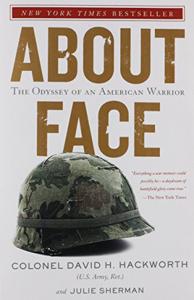
Want to learn the ideas in About Face better than ever? Read the world’s #1 book summary of About Face by David H. Hackworth, Julie Sherman here.
Read a brief 1-Page Summary or watch video summaries curated by our expert team. Note: this book guide is not affiliated with or endorsed by the publisher or author, and we always encourage you to purchase and read the full book.
Video Summaries of About Face
We’ve scoured the Internet for the very best videos on About Face, from high-quality videos summaries to interviews or commentary by David H. Hackworth, Julie Sherman.
1-Page Summary of About Face
Make an Emotional Connection
A diet drink commercial starts with several beautiful women in colorful dresses dancing to a happy beat. At first, you might think that the ad is on target and will help sell the product. However, research proved otherwise. When middle-aged women watched the spot, they didn’t feel uplifted; instead, they felt depressed because of the tagline “Pump it up” and how thin the models looked. The target audience assumed that those models spent hours at a gym working on their perfect figures instead of enjoying life. Therefore, this group felt excluded from society and sad for not looking like them or spending time at a gym to look good like them.
While the advertisement was on-message, it failed to connect emotionally with its target audience. Consumers who are emotionally engaged are more likely to buy a product than those who merely know about it. This failure might explain why so much advertising fails. It is said that half of all advertising is wasted, but marketers don’t know which half.
Researchers have learned to identify consumers’ emotional reactions to advertising by reading their facial expressions, a noninvasive technique that experts use to monitor muscle movements on the face. By doing this, you can tailor your ad campaigns and trigger emotional responses in customers. To do so effectively, leverage the “three _P_s”:
- Passion is the way in which consumers respond to ads. It’s driven by sensory perceptions, and it ties to a brand’s functionality. The purpose of branding is for people to connect with a brand based on its values and beliefs. A brand has personality if it comes across as emotionally engaging, unique, authentic and giving it character.
The 10 Guidelines for Emotionally Effective Advertising
To create effective ads, follow these 10 steps:
1. “Get Physical”
Advertising has to be better than the competition’s. It needs to grab people’s attention and engage their senses in order for it to be effective. For example, Billy Mays was an effective spokesperson because he stopped people in their tracks with his loud approach and engaged their five senses through up-tempo advertising.
Ads have only a few seconds to make an impact. Humans are very visual creatures, so images can be powerful and persuasive. The old saying is true: A picture is worth a thousand words. People look at ads in specific ways, including focusing on faces or action in the ad (such as movement). Therefore, placing images of people or moving objects will capture attention more than still pictures. Continuous motion or sudden movements also draw attention to ads and help them stand out from other visuals. Engaging all five senses (sight, sound, touch, smell and taste) is better than using just one sense alone because it helps consumers connect with the product advertised. Innovative methods of engaging multiple senses include scratch-and-sniff inserts that allow consumers to experience scents; food samples for taste; textured ads that give tactile experiences beyond sight; video clips that engage both sight and sound together; etc
2. “Keep It Simple”
If an ad is confusing or boring, it’s ineffective. If the ad is too complex and takes a long time to understand, then you won’t get people excited about it. The only way to go is “Keep It Simple Stupid” (KISS). Think of a billboard; if someone can’t figure out its message in half a second, then the billboard was wasted money. Good design makes things easy for viewers by using visuals that are arranged in order of importance so that your eye goes from one important visual to another important visual without getting distracted by other parts of the image. A logo placed at the bottom right corner disappears into what’s called “the death corner,” which people typically see last because they’re not interested in looking at something tiny like that when they could be looking at something more interesting!





